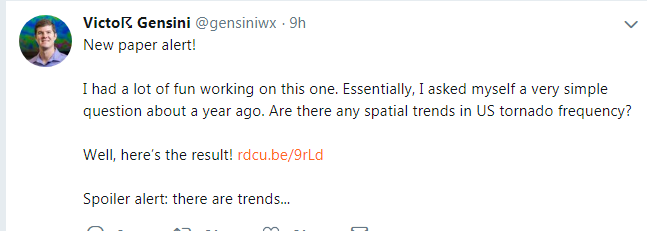17 October 2018
Is A Changing Climate Shifting Tornado Alley?
Posted by Dan Satterfield
 An important paper by Harold Brooks and Victor Gensini is out today, and it looks at how the atmospheric conditions that produce tornadoes have changed since 1979. The data shows a clear shift toward the Southeast U.S. with a decrease in the Plains. This is not good since the increase is in an area of higher population, and in an area where a larger percentage of people live in tornado death traps. These traps are sometimes known as mobile homes.
An important paper by Harold Brooks and Victor Gensini is out today, and it looks at how the atmospheric conditions that produce tornadoes have changed since 1979. The data shows a clear shift toward the Southeast U.S. with a decrease in the Plains. This is not good since the increase is in an area of higher population, and in an area where a larger percentage of people live in tornado death traps. These traps are sometimes known as mobile homes.
The paper, by two scientists who I consider top experts in the field, may turn out to be another climate change surprise. Harold Brooks said the findings surprised him, but he also pointed out that the current change is equal to just one more tornado a decade, in an area of one square degree, so the average person living in the region would not likely notice the change. Over the entire region though, there has been an increase in conditions favorable for tornadoes going east, with a decrease in the High Plains.
This change is what would be expected as the climate warms. As the Great Plains gets hotter and drier (predicted by almost all climate models), the dry line will move eastward and since many of the plains tornadoes form from dryline storms, they will develop farther eastward. Increasing temperatures and warmer ocean waters lead to higher dew points in the Southeast U.S. which is also favorable for more intense thunderstorm updrafts.

This graphic (from the Brooks-Gensini paper) shows increasingly favorable tornado conditions in the SE with a decrease in the west. This is not showing tornado reports, but is showing a parameter called the Significant Tornado Parameter. The STP shows when the atmospheric wind shear and instability are favorable for tornadoes to develop.
A couple of decades ago it was considered very possible that climate change would not have a major impact on tornado numbers, and if anything there might be fewer of them, due to less wind shear in a warmer world. Nobody really knew for sure, and one of the first people to take a rigorous scientific look at the question was Harold Brooks, one of the co-authors of today’s paper. Then a year ago, co-author Gensini started wondering about the spatial extent and he described how it happened on his Twitter account today:
This is how science is supposed to work. Ask a question, find the answer, and accept it even if it conflicts with your politics.
This paper is getting a lot of media attention, and it should; It’s a surprise and it has consequences. Seth Borenstein at AP has a good summary of the paper and the Capital Weather Gang at the Washington Post have a story on it as well. Interestingly, this increased threat of tornadoes is in an area where a majority of residents think that climate change is not real.
Mother Nature often gets the last laugh.



 Dan Satterfield has worked as an on air meteorologist for 32 years in Oklahoma, Florida and Alabama. Forecasting weather is Dan's job, but all of Earth Science is his passion. This journal is where Dan writes about things he has too little time for on air. Dan blogs about peer-reviewed Earth science for Junior High level audiences and up.
Dan Satterfield has worked as an on air meteorologist for 32 years in Oklahoma, Florida and Alabama. Forecasting weather is Dan's job, but all of Earth Science is his passion. This journal is where Dan writes about things he has too little time for on air. Dan blogs about peer-reviewed Earth science for Junior High level audiences and up.